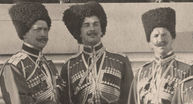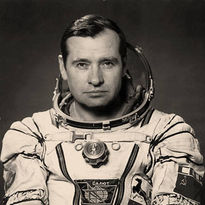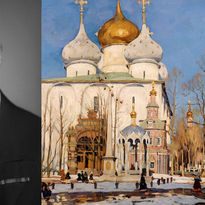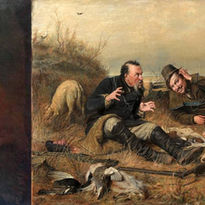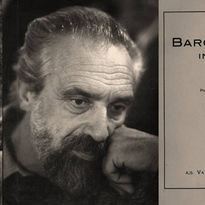OTHER FAMOUS FAMILY FIGURES

ANATOLY BYKANOV (20.03.1937– 2015)
COMPOSER, FILM COMPOSER, CONDUCTOR
Professor at the Moscow Tchaikovsky Conservatory,
Director of the Central Music School at the Tchaikovsky Conservatory
Creator & director of the Rokkko ensemble
Alma mater - The Moscow Tchaikovsky Conservatory
Student of Dmitry Kabalevsky and Sergey Balasanian
Actively worked with Muslim Magomayev, Georgy Vitsin, Andrei Mironov, Yury Yakovlev and Anatoly Gorokhov

INNOKENTY SEREDIN (09.12.1898 – 01.06.1981)
Guard Major-General of Artillery
Division commander
Alma mater - Peter the Great Military Academy of the Strategic Missile Forces
World War II
STATE AWARDS:
1. Order of Lenin
2. Order of the Red Banner 1.
3. Order of the Red Banner 2.
4. Order of the Red Banner 3.
5. Order of the Red Banner 4.
6. Order of the Red Banner 5.
7. Order of the Red Banner 6.
8. Order of Suvorov II degree
10. Order of the Patriotic War, 1st degree
11. Order of the Red Star
12. Medal for Military Merit
13. Medal "For victory over Germany in the Great Patriotic War of 1941-1945"
14. Medal "For the Capture of Berlin"
15. Medal "For the Liberation of Warsaw"
16. Cross of the Brave
17. Medal "For Warsaw 1939-1945"
18. Medal "Veteran of the Armed Forces of the USSR"
19. Jubilee medal "Twenty years of Victory in the Great Patriotic War
20. 1941-1945" (7 May 1965)
21. Jubilee medal "Thirty years of Victory in the Great Patriotic War 1941-1945"
22. Medal "30 years of the Soviet Army and Navy"
23. Anniversary medal "40 years of the Armed Forces of the USSR"
24. Anniversary medal "50 years of the Armed Forces of the USSR"
25. Anniversary medal "60 years of the Armed Forces of the USSR"
Badge "Guard"
Badge of the USSR Ministry of Defense "25 years of Victory in the Great Patriotic War"
Friend and Chef
Marshal of the Soviet Union - Georgy Zhukov
HIS WELL BORN ALEXEI MAKUHO
(1912 –08.12.1937)
Writer, publicist,
godson of Nikolai Romanov - Emperor of All Russia, Tsar of Poland and Grand Duke of Finland
Alma mater -

HIS HIGH WELL BORN BORIS MAKUHO
(11.01.1883 – 08.04.1931)
Guard Colonel, cavalry
His Imperial Majesty's Own Escort
Alma mater - Nikolaev Cavalry School
Russo-Japanese War 1904-1905
STATE AWARDS:
Order of St. Anne, 4th class with the inscription "For bravery" (1904)
Order of St. Anne, 3rd class with swords and bow
Order of St. Anne 2nd class with swords
Order of St. Stanislaus, 3rd class with swords and bow
Order of St. Stanislaus, 2nd class with swords (1905)
Order of St. Vladimir, 4th degree
Medal “In Memory of the 200th Anniversary of the Poltava Victory”
Hereditary sign of the 300th ANNIVERSARY OF THE REIGN OF THE HOUSE OF ROMANOV
Sign of His Imperial Majesty's Own convoy
Sign of the Terek Cossack Army
Sign - Memory of the conquest of the 50th anniversary of the Eastern Caucasus

HIS EXCELLENCY KONSTANTIN TKACHEV
(1880 - 1938*)
COMPOSER, CONDUCTOR (CHURCH MUSIC),
Military figure, cavalry
Knight of the Order of St. George
Friend and associate of Count Illarion Vorontsov-Dashkov - the Governor-General of the Caucasus Viceroyalty
Alma mater -

HIS EXCELLENCY YAKOV MAKUHO
(23.10.1848 - 1916*)
Guard Major -General of Artillery (horse artillery)
Alma mater - Don Officer Artillery School
Russo-Turkish War (1877–1878)
Ahal-Teke expedition 1879
STATE AWARDS:
Order of St. Anna 2nd degree (1895)
Order of St. Anne 3rd class with swords and bow (1878)
Order of St. Anne, 4th class with the inscription "For bravery"
Order of St. Stanislav 2nd class with swords (1880)
Order of St. Stanislaus 3rd class with swords (1874)
Order of St. Vladimir, 3rd class. (1906)
Order of St. Vladimir, 4th class. with a bow “for 25 years of impeccable service in officer ranks” (1901)
Medal "For labors in the excellent implementation of the general mobilization of 1914" on the White Eagle ribbo

HIS HIGH WELL BORN DMITRIY MAKUHO
(1844 – 1920)
Colonel, cavalry
Chief of Army Staff Makuho
Head of the District Quartermaster Directorate of the Caucasian Military District
Alma mater -
Russo-Turkish War (1877–1878)
Member of military expeditions (1872-1873)
STATE AWARDS:
Order of St. Stanislaus 3rd class. with swords and bow
Order of St. Stanislaus 2nd class. with swords and bow
Order of St. Anne 3rd class
Order of St. Vladimir, 4th class
HIS WELL BORN YAKOV MAKUHO
(1808 –1888)
Esaul, cavalry
Friend and associate of Ivan Fyodorovich Paskevich-Erevansky, Serene Prince of Warsaw
Alma mater -
Russo-Turkish War (1828-1829)
Capture of Warsaw (08.25-26.1831)
War with Chechnya (1846-1848)
STATE AWARDS:
Insignia of the Military Order of St. Georgiy for Russo-Turkish War
Polish insignia for military merit 5th class
Medal "For the Turkish War"Medal "for the capture of Warsaw"
INFORMATION ABOUT EDUCATIONAL INSTITUTIONS
Educational institutions are listed in order of foundation
Peter the Great Military Academy of the Strategic Missile Forces
(Mikhailovskoe Artillerieschule)
1820
Innokenty Seredin graduated from this educational institution
It is one of the leading institutions of higher military and higher technical domestic education. For almost two centuries, it has repeatedly changed its purpose and, accordingly, its name. Its history dates back to the officer classes of the Artillery School, officially opened on November 25 (old style) - December 7 (NS), 1820 in St. Petersburg. In 1845 the school was given the name Mikhailovsky. Since 1855 - Mikhailovsky Artillery Academy; since 1919 - Artillery Academy of the Red Army; since 1925 - Military Technical Academy of the Red Army; since 1926 - Military Technical Academy named after F. E. Dzerzhinsky; since 1932 - Military Artillery Academy of the Red Army; since 1934 - Artillery Academy of the Red Army named after F. E. Dzerzhinsky. In 1938 she was transferred to Moscow, in 1941-1944 she was stationed in the city of Samarkand (Uzbek SSR). In 1945, a jet weapons department was created at the academy and the training of rocket engineers began. In 1953, there was a division into two academies - the Military Artillery Engineering Academy named after F. E. Dzerzhinsky with a deployment in Moscow and the Military Artillery Academy named after M. I. Kalinin in the historical building of the Mikhailovsky Artillery Academy in Leningrad, now St. Petersburg.
On March 24, 1960, it was introduced into the Strategic Missile Forces. Since 1963 - Military Engineering Academy named after F. E. Dzerzhinsky; since 1972 - Military Academy named after F. E. Dzerzhinsky; from August 25, 1997 - Military Academy of the Strategic Missile Forces named after Peter the Great. In 1998, by Decree of the Government of the Russian Federation No. 1009, it was reorganized into the Military Academy of Strategic Missile Forces named after Peter the Great with a branch in the city of Kubinka (formerly the Moscow Higher School of Air Defense Radioelectronics). In 2008, as separate formations (in fact, branches) as part of the reform of military education by order of the Government of the Russian Federation, the Serpukhov Military Institute of Missile Forces and the Rostov Military Institute of Missile Forces named after Chief Marshal of Artillery M. I. Nedelin became part of the academy.
For a long period, the Mikhailovsk Military Artillery Academy was a center for the development of weapons theory, the development of the fundamentals for the design and production of firearms, missiles, and mine-explosive devices - means of defeating and destroying the enemy. The works of N.V. Maievsky, K.I. Konstantinov, A.V. Gadolin, D.K. Chernov, S.I. Mosin, G.A. Zabudsky, V.N. Ipatiev, M.M. won worldwide fame. Pomortsev, V. M. Trofimov, N. F. Drozdov, D. A. Ventsel, I. P. Grave, M. E. Serebryakova and others.
Famous graduates of the educational institution
Nikolaev Cavalry School
09.05.1823 -1917
His High Well Born Boris Makuho graduated from this educational institution
A privileged military school of the Russian Empire, which existed in St. Petersburg from 1823 to 1917. The school's graduates included many prominent military and civilian figures in Russia in the 19th and early 20th centuries.
From the moment of its creation until the February Revolution, only hereditary nobles - teachers and cadets - were accepted into service at the Nicholas Cavalry School. Initially, there were no certain standards of secondary education for admission to school by a cadet of private rank. Subsequently, the school accepted the most successful graduates of the cadet corps: it was necessary to have at least 9 points in science and 8 points in behavior.
The school trained officers for both regular cavalry and Cossack troops. Since 1890, the school's cadets were administratively divided into a squadron and a hundred: 250 cadets in a squadron, 120 in a hundred.
The course of study was a two-year course, and its ultimate goal was to prepare graduates for regimental cavalry service. The main academic subjects were tactics, military affairs, topography, military administration, hippology, artillery, fortification, law, hygiene and drawing; general education subjects taught the Law of God, Russian, French and German languages, mathematics, mechanics, geography, physics, chemistry, history, economics, government and psychology.
Upon completion of training, the squadron's cadets were graduated as cornets into the guards and army cavalry, and hundreds of cadets were graduated as cornets into the Cossack cavalry. There was an opportunity to take exams for a college course as an external student.
Since 1864, graduation was carried out after the summer camp gathering, since one camp gathering (after the 1st year) was considered insufficient. At first, the best graduates were sent to artillery and engineering troops, but soon graduation from combined arms schools into these types of troops was stopped.
Famous graduates of the educational institution
Bauman Moscow State Technical University
1830
Anton Seredin graduated from this educational institution
Russian national research university, scientific center, especially valuable object of cultural heritage of the peoples of Russia.
The previous name of the university was “Moscow Higher Technical School named after. N. E. Bauman" was assigned to him in honor of the revolutionary Nikolai Ernestovich Bauman, who was killed in 1905 near the main building at that time - the Imperial Moscow Technical School.
MSTU provides training in more than 70 specialties. In 2019, about 21,500 students studied at the university; over 4,500 professors and teachers are involved in the educational process of the university, including 450 doctors of science and about 3,000 candidates of science. In the period from 1918 to 1997, over 120,000 specialists were trained, most of whom connected their lives with scientific and design activities, working at the largest mechanical and instrument making enterprises. Some branch faculties of MSTU are also located in cities near Moscow: Krasnogorsk, Reutov, Korolev, and there is also a branch in Kaluga. By order of the Ministry of Education and Science of Russia dated April 12, 2016 No. 397, the Moscow State Forest University was affiliated with the N. E. Bauman MSTU as a separate structural unit, becoming the Mytishchi branch of the N. E. Bauman MSTU.
During the existence of the university, over 200,000 engineers have been trained there.
In 2018, MSTU entered the top 150 global universities for the employment of graduates; the ranking was compiled by the consulting company Emerging and is based on the opinions of employers in 22 countries.
In 2024, MSTU ranks 6th in the overall ranking of Russian universities according to RAEX.
Famous graduates of the educational institution
Imperial School of Jurisprudence
A CLOSED-TYPE EDUCATIONAL INSTITUTION FOR HEREDITARY NOBLES
29.05.1833 - 18.06.1918
His Excellency Georgy Tkachev graduated from this educational institution
The school was opened in December 1835 and already in 1840 the first graduation of 14 civil servants took place. In total, during the years of the school's existence until the beginning of 1918, more than 2,000 professionals were trained, who left a noticeable mark on the social and cultural life of Russia.
On the initiative of the Tsar's nephew, Prince Peter of Oldenburg and with the close participation of M. M. Speransky, with the aim of educating legally competent personnel for administrative and judicial activities, the charter and staff of the new School of Law under the Ministry of Justice were approved by decree of Nicholas I on May 29, 1835.
Pyotr Georgievich Oldenburgsky, appointed as the trustee of the school, purchased for it from the heirs of Senator I. N. Neplyuev a house on the Fontanka River Embankment, 6 (opposite the Summer Garden), for 700,000 rubles. The house was rebuilt by architects A. I. Melnikov and V. P. Stasov. State Councilor S. A. Poshman was appointed director of the school, and professor of the Tsarskoye Selo Lyceum E. V. Wrangel was appointed inspector. On December 7, 1835, two days after the grand opening, classes began at the new school.
The school was a privileged closed educational institution and was equal in status to the Tsarskoye Selo Lyceum. It accepted up to 100 sons of hereditary nobles aged 12 to 17. The school was fee-based, but tuition for state-funded students was paid for by the treasury.
The duration of study was initially set at 6 years, but from 1838 it was increased to 7 years with a division into two courses: junior - gymnasium (grades VII, VI, V and IV) and senior - university (grades III, II and I). Since 1847, preparatory classes were established at the school (since 1856, three-year classes).
In the junior year, they studied the classical gymnasium program in full (however, Greek was replaced by natural science), and in the university year, they studied the encyclopedia of jurisprudence (basic law course), church, Roman, civil, commercial, criminal and state law, civil and criminal proceedings, the history of Roman law, international law, forensic medicine, police law, political economy, financial laws, the history of religions, the history of philosophy, in connection with the history of the philosophy of law, Latin and English (German and French were also optional).
A library was created at the school, and later a museum of the history of the school. The book collection was based on 364 volumes (184 works), purchased from the bookseller Smirdin by the time the school opened. The following year, the library was replenished with a complete collection of laws in 80 volumes. In 1838, a library of French books and geographical maps was purchased for the library. Publications from various educational institutions were sent to the library as gifts - scientific notes, dissertations, and others. By 1885, the collection numbered about 6,000 books. The library subscribed to general and specialized Russian and foreign periodicals.
The cost of maintaining the school at the end of the 19th century was 225,000 rubles annually; of which 90,000 were released from the treasury, and the rest was reimbursed by fees for the maintenance of students. In order to provide financial assistance to needy students and graduates, as well as their families, in 1885 the charter of the Legal Fund was approved, the members of which were, first of all, former students of the school - mostly high-ranking dignitaries who paid annual or one-time contributions.
All graduates were required to serve 6 years in the institutions of the Ministry of Justice. Those who graduated from the school with honors received the ranks of the IX and X classes (titular councilor and collegiate secretary - equivalent to a staff captain and lieutenant in the army) and were sent mainly to the chanceries of the Ministry of Justice and the Senate; others were sent to judicial places in the provinces, in accordance with the successes of each.
Noting the activity of preparing “young noblemen for civil service in the judicial branch,” Alexander III, in a rescript on the occasion of the 50th anniversary of the school, called for further directing “their efforts to the upbringing of Russian youth, affirming their students in the rules of faith, truth and good morality and in unwavering devotion to the Throne and the Fatherland.” Over the years of its existence, the School of Law, which was one of the few legal educational institutions in Russia, was able to prepare more than 2,000 highly qualified lawyers.
The Surikov Moscow State Art Institute
(Moscow School of Painting, Sculpture and Architecture)
1843
Svetlana Seredina graduated from this educational institution
Nelli Bukanova graduated from this educational institution
Among the higher educational institutions of Russia that train professionals of all profiles in the field of fine arts, the Moscow State Academic Art Institute named after V.I. Surikov rightfully occupies a leading position along with the St. Petersburg State Academic Institute of Painting, Sculpture and Architecture named after I.E. Repina.
Your pedigree MGAHI named after. IN AND. Surikov leads from the Moscow School of Painting and Sculpture, founded in 1843 under the Moscow Art Society. The traditions established within the walls of the MUZHV and the Imperial Academy of Arts became fundamental in the development and development of theoretical and practical programs of the educational process at the Surikov Institute. Every year, about 600 undergraduate and graduate students from the Russian Federation, CIS countries and a number of foreign countries study at the university. Along with general humanities disciplines, they study classical drawing and graphics, painting, sculpture, and, since 2001, architecture. The institute also trains restorers of paintings and sculptures.
Famous graduates of the educational institution
Tchaikovsky Moscow State Conservatory
1866
Anatoly Bykanov graduated from this educational institution
Tchaikovsky Moscow State Conservatory is a higher music educational institution in Moscow, one of the leading music universities in Russia and the world. It was founded in 1866 on the basis of N.G. Rubinstein in 1860, music classes of the Moscow branch of the Imperial Russian Musical Society.
The Moscow Conservatory is approaching its 150th anniversary. Its history contains many bright pages, including those related to concert life. The stages of the Big, Small and Rachmaninov Halls remember the performance of the best musicians in the world, who generously gave their art to the capital's listeners.
Famous graduates of the educational institution
Technical University of Munich
1868
Anton Seredin graduated from this educational institution
The Technical University of Munich (German: Technische Universität München, TU München, TUM), founded in 1868, is located in the city of Munich and is the only technical university in Bavaria and one of the largest higher education institutions in Germany. The university is part of the association of technical universities in Germany TU 9 and is the most prestigious university in Germany.
The university provides training in 132 specialties. Along with the faculties of technical and natural sciences typical for a technical university, there are also faculties of economics, sports and medicine. In some specialties, teaching is conducted in both German and English.
Famous graduates of the educational institution
Don Officer Artillery School 1872-1917
His Excellency Yakov Makuho graduated from this educational institution
On February 19, 1872, the temporary Regulations on the Don Artillery School were approved by the Highest. The school was opened with the aim of eliminating shortcomings in the training of junior command personnel in the Cossack artillery batteries of these troops. The Regulations indicated that they were adopted as a temporary measure, pending the introduction of the Regulations on District Artillery Schools being developed in the Main Artillery Directorate.
Students were selected for the Don School for preferential troops; batteries that were in field external service (not on benefits) were supposed to send Cossacks to district fireworks schools (non-commissioned officer rank in the artillery units of the Russian Imperial Army).
The school recruited Cossacks who had served no more than 2 years and Cossacks from among those enrolled in the service ranks. All applicants to artillery schools had to be literate, preference was given to those who had higher knowledge of the subjects taught at the school. Cossacks entering schools had to purchase at their own expense uniforms, edged weapons and riding horses, 4 pairs of underwear, two pairs of boots, a blanket and two sheets. The duration of schooling was two years. The training program included the following subjects: the law of God, the Russian language, arithmetic, artillery, basic information from geometry and fortification. The training was based on practical exercises, which developed stable knowledge in future civil servants in their specialty. At the end of school, Cossacks were graduated as bombardiers (corresponding to corporal), with the right to be promoted to non-commissioned officer after 6 months. If there was no vacancy, they were promoted with seniority from the date of graduation. Low-performing students could be retained for a second year if they behaved well. School commanders had the rights of Commander of a field artillery battery. Officer teachers were selected from among those who had served in the ranks for at least 2 years. In addition to teaching, they were in charge of departments (study groups), and they appointed police officers or fireworksmen (two per class) as assistants. Cossacks who studied at school received a benefit: for each year of study, two years of benefits. Cossack Artillery schools differed in staff. At the Don Artillery School, the staff was determined to be: 5 officers, 9 non-commissioned officers and 90 students.
.
The Art Academy of Latvia
04.05.1919
Svetlana Seredina graduated from this educational institution
Igor Seredin graduated from this educational institution
State higher education institution of Latvia. Founded in 1919 on the initiative of one of the first Latvian professional artists, academician Vilhelms Purvitis (1872-1945), who became the first rector of the educational institution. The building where the academy is located was built in 1902-1904 according to the design of the architect V. Boxlaff for the Riga Commercial School. The Academy provides higher education in the field of fine arts with degrees: Bachelor of Arts, Master of Arts and Doctor of Art History. Throughout all the years of its existence, including the Soviet period, teaching at the academy was conducted only in Latvian.
Famous graduates of the educational institution
MAXY
1925
Nelli Bukanova graduated from this educational institution
Anton Seredin graduated from this educational institution
Svetlana Seredina graduated from this educational institution
Igor Seredin graduated from this educational institution
The Moscow Academic Art School was founded in 1925. The names of famous cultural figures are associated with the activities of the school. His teachers and artistic directors over the years were full members of the USSR Academy of Arts V.I. Baksheev and A.M. Gerasimov, corresponding member of the USSR Academy of Arts N.P. Krymov, Honored Artist of the RSFSR, Professor V.A. Shestakov, professor S.N. Frolov, associate professor K.F. Morozov, artists P.K. Petrovichev, P.A. Radimov, Honored Artists of the RSFSR A.I. Sakhanov, A.M. Dubinchik, M.V. Dobroserdov and others. And currently the school employs a team of highly qualified teachers, many of whom have received honorary titles and state awards. Within the walls of the school, outstanding figures of our culture received a start in life: folk artists, members of the Academy of Arts, laureates of state prizes Yu.P. Kugach and D.K. Mochalsky, USSR State Prize laureate, poster artist V.S. Ivanov, corresponding members of the Academy of Arts - A.P. Vasiliev, M.A. Bogdanov, O.K. Komov, L.A. Sokolov, rector of MGAHI named after. IN AND. Surikova, People's Artist of the Russian Federation, Vice-President of the Russian Academy of Arts - Lyubavin Anatoly Alexandrovich. Graduates of the school were awarded honorary titles: “Honored Artist of the Russian Federation”, “Honored Artist of the Russian Federation”, “Honored Worker of Culture of the Russian Federation”. The Moscow Academic Art School is a leading educational institution, methodological center, and developer of the content of secondary vocational art education in the Russian Federation.
In 1995, the board of the Ministry of Culture of the Russian Federation awarded the school the honorary title “Academic” for its great services in the development of art education. In honor of the 75th anniversary, the School was awarded the Gold Medal of the Russian Academy of Arts































